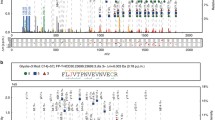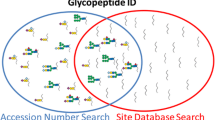Abstract
Protein glycosylation drives many biological processes and serves as markers for disease; therefore, the development of tools to study glycosylation is an essential and growing area of research. Mass spectrometry can be used to identify both the glycans of interest and the glycosylation sites to which those glycans are attached, when proteins are proteolytically digested and their glycopeptides are analyzed by a combination of high-resolution mass spectrometry (MS) and tandem mass spectrometry (MS/MS) methods. One major challenge in these experiments is collecting the requisite MS/MS data. The digested glycopeptides are often present in complex mixtures and in low abundance, and the most commonly used approach to collect MS/MS data on these species is data-dependent acquisition (DDA), where only the most intense precursor ions trigger MS/MS. DDA results in limited glycopeptide coverage. Semi-targeted data acquisition is an alternative experimental approach that can alleviate this difficulty. However, due to the massive heterogeneity of glycopeptides, it is not obvious how to expediently generate inclusion lists for these types of analyses. To solve this problem, we developed the software tool GlycoPep MassList, which can be used to generate inclusion lists for liquid chromatography tandem-mass spectrometry (LC-MS/MS) experiments. The utility of the software was tested by conducting comparisons between semi-targeted and untargeted data-dependent analysis experiments on a variety of proteins, including IgG, a protein whose glycosylation must be characterized during its production as a biotherapeutic. When the GlycoPep MassList software was used to generate inclusion lists for LC-MS/MS experiments, more unique glycopeptides were selected for fragmentation. Generally, ∼30 % more unique glycopeptides can be analyzed per protein, in the simplest cases, with low background. In cases where background ions from proteins or other interferents are high, usage of an inclusion list is even more advantageous. The software is freely publically accessible.

Software increases the number of glycopeptides that get selected for MS/MS analysis.




Similar content being viewed by others
References
Dwek RA. Glycobiology: toward understanding the function of sugars. Chem Rev. 1996;96(2):683–720. doi:10.1021/cr940283b.
Deribe YL, Pawson T, Dikic I. Post-translational modifications in signal integration. Nat Struct Mol Biol. 2010;17(6):666–72. doi:10.1038/nsmb.1842.
Raman R, Raguram S, Venkataraman G, Paulson JC, Sasisekharan R. Glycomics: an integrated systems approach to structure-function relationships of glycans. Nat Methods. 2005;2(11):817–24. doi:10.1038/nmeth807.
Harvey DJ. Proteomic analysis of glycosylation: structural determination of N- and O-linked glycans by mass spectrometry. Expert Rev Proteomics. 2005;2(1):87–101. doi:10.1586/14789450.2.1.87.
Dell A, Morris HR. Glycoprotein structure determination by mass spectrometry. Science. 2001;291(5512):2351–6. doi:10.1126/science.1058890.
Go EP, Rebecchi KR, Dalpathado DS, Bandu ML, Zhang Y, Desaire H. GlycoPep DB: a tool for glycopeptide analysis using a “smart search”. Anal Chem. 2007;79(4):1708–13. doi:10.1021/ac061548c.
Wormald MR, Dwek RA. Glycoproteins: glycan presentation and protein-fold stability. Structure. 1999;7(7):R155–60. doi:10.1016/s0969-2126(99)80095-1.
Nagae M, Yamaguchi Y. Function and 3D structure of the N-glycans on glycoproteins. Int J Mol Sci. 2012;13(7):8398–429. doi:10.3390/ijms13078398.
Kolarich D, Lepenies B, Seeberger PH. Glycomics, glycoproteomics and the immune system. Curr Opin Chem Biol. 2012;16(1–2):214–20. doi:10.1016/j.cbpa.2011.12.006.
Leymarie N, Griffin PJ, Jonscher K, Kolarich D, Orlando R, McComb M, et al. Interlaboratory study on differential analysis of protein glycosylation by mass spectrometry: the ABRF glycoprotein research multi-institutional study 2012. Mol Cell Proteomics. 2013;12(10):2935–51. doi:10.1074/mcp.M113.030643.
Grass J, Pabst M, Chang M, Wozny M, Altmann F. Analysis of recombinant human follicle-stimulating hormone (FSH) by mass spectrometric approaches. Anal Bioanal Chem. 2011;400(8):2427–38. doi:10.1007/s00216-011-4923-5.
Fuster MM, Esko JD. The sweet and sour of cancer: glycans as novel therapeutic targets. Nat Rev Cancer. 2005;5(7):526–42. doi:10.1038/nrc1649.
Gornik O, Lauc G. Glycosylation of serum proteins in inflammatory diseases. Dis Markers. 2008;25(4–5):267–78. doi:10.1155/2008/493289.
Saroha A, Biswas S, Chatterjee BP, Das HR. Altered glycosylation and expression of plasma alpha-1-acid glycoprotein and haptoglobin in rheumatoid arthritis. J Chromatogr B Analyt Technol Biomed Life Sci. 2011;879(20):1839–43. doi:10.1016/j.jchromb.2011.04.024.
Perdivara I, Deterding LJ, Cozma C, Tomer KB, Przybylski M. Glycosylation profiles of epitope-specific anti-beta-amyloid antibodies revealed by liquid chromatography-mass spectrometry. Glycobiology. 2009;19(9):958–70. doi:10.1093/glycob/cwp038.
Fujimura T, Shinohara Y, Tissot B, Pang PC, Kurogochi M, Saito S, et al. Glycosylation status of haptoglobin in sera of patients with prostate cancer vs. benign prostate disease or normal subjects. Int J Cancer. 2008;122(1):39–49. doi:10.1002/ijc.22958.
Qiu Y, Patwa TH, Xu L, Shedden K, Misek DE, Tuck M, et al. Plasma glycoprotein profiling for colorectal cancer biomarker identification by lectin glycoarray and lectin blot. J Proteome Res. 2008;7(4):1693–703. doi:10.1021/pr700706s.
Drake PM, Schilling B, Niles RK, Prakobphol A, Li B, Jung K, et al. Lectin chromatography/mass spectrometry discovery workflow identifies putative biomarkers of aggressive breast cancers. J Proteome Res. 2012;11(4):2508–20. doi:10.1021/pr201206w.
Stowell SR, Ju T, Cummings RD. Protein glycosylation in cancer. Annu Rev Pathol. 2015;10:473–510. doi:10.1146/annurev-pathol-012414-040438.
Ohtsubo K, Marth JD. Glycosylation in cellular mechanisms of health and disease. Cell. 2006;126(5):855–67. doi:10.1016/j.cell.2006.08.019.
Dube DH, Bertozzi CR. Glycans in cancer and inflammation-potential for therapeutics and diagnostics. Nat Rev Drug Discov. 2005;4(6):477–88. doi:10.1038/nrd1751.
Goldberg D, Bern M, Parry S, Sutton-Smith M, Panico M, Morris HR, et al. Automated N-glycopeptide identification using a combination of single- and tandem-MS. J Proteome Res. 2007;6(10):3995–4005. doi:10.1021/pr070239f.
Desaire H. Glycopeptide analysis, recent developments and applications. Mol Cell Proteomics. 2013;12(4):893–901. doi:10.1074/mcp.R112.026567.
Dalpathado DS, Desaire H. Glycopeptide analysis by mass spectrometry. Analyst. 2008;133(6):731–8. doi:10.1039/b713816d.
Desaire H, Hua D. When can glycopeptides be assigned based solely on high-resolution mass spectrometry data? Int J Mass Spectrom. 2009;287(1–3):21–6. doi:10.1016/j.ijms.2008.12.001.
Mechref Y. Use of CID/ETD mass spectrometry to analyze glycopeptides. Curr Protoc Protein Sci. 2012;12(11):1–11. doi:10.1002/0471140864.ps1211s68.
Quan L, Liu M. CID, ETD and HCD fragmentation to study protein post-translational modifications. Mod Chem Appl. 2012;1(1), e102. doi:10.4172/mca.1000e102.
Aldredge D, An HJ, Tang N, Waddell K, Lebrilla CB. Annotation of a serum N-glycan library for rapid identification of structures. J Proteome Res. 2012;11(3):1958–68. doi:10.1021/pr2011439.
Li F, Glinskii OV, Glinsky VV. Glycobioinformatics: current strategies and tools for data mining in MS-based glycoproteomics. Proteomics. 2013;13(2):341–54. doi:10.1002/pmic.201200149.
Gagneux P, Varki A. Evolutionary considerations in relating oligosaccharide diversity to biological function. Glycobiology. 1999;9(8):747–55.
Schmidt A, Gehlenborg N, Bodenmiller B, Mueller LN, Campbell D, Mueller M, et al. An integrated, directed mass spectrometric approach for in-depth characterization of complex peptide mixtures. Mol Cell Proteomics. 2008;7(11):2138–50. doi:10.1074/mcp.M700498-MCP200.
Liu T, Qian W-J, Gritsenko MA, Camp II DG, Monroe ME, Moore RJ, et al. Human plasma N-glycoproteome analysis by immunoaffinity subtraction, hydrazide chemistry, and mass spectrometry. J Proteome Res. 2005;4(6):2070–80. doi:10.1021/pr0502065.
Madera M, Mechref Y, Novotny MV. Combining lectin microcolumns with high-resolution separation techniques for enrichment of glycoproteins and glycopeptides. Anal Chem. 2005;77(13):4081–90. doi:10.1021/ac050222l.
Hart-Smith G, Low JK, Erce MA, Wilkins MR. Enhanced methylarginine characterization by post-translational modification-specific targeted data acquisition and electron-transfer dissociation mass spectrometry. J Am Soc Mass Spectrom. 2012;23(8):1376–89. doi:10.1007/s13361-012-0417-8.
Wu Y, Mechref Y, Klouckova I, Mayampurath A, Novotny MV, Tang H. Mapping site-specific protein N-glycosylations through liquid chromatography/mass spectrometry and targeted tandem mass spectrometry. Rapid Commun Mass Spectrom. 2010;24(7):965–72. doi:10.1002/rcm.4474.
Froehlich JW, Dodds ED, Wilhelm M, Serang O, Steen JA, Lee RS. A classifier based on accurate mass measurements to aid large scale, unbiased glycoproteomics. Mol Cell Proteomics. 2013;12(4):1017–25. doi:10.1074/mcp.M112.025494.
Varki A. Loss of N-glycolylneuraminic acid in humans: mechanisms, consequences, and implications for hominid evolution. Am J Phys Anthropol. 2001;116(33):54–69. doi:10.1002/ajpa.10018.
Stadlmann J, Pabst M, Kolarich D, Kunert R, Altmann F. Analysis of immunoglobulin glycosylation by LC-ESI-MS of glycopeptides and oligosaccharides. Proteomics. 2008;8(14):2858–71. doi:10.1002/pmic.200700968.
Selman MHJ, Derks RJE, Bondt A, Palmblad M, Schoenmaker B, Koeleman CAM, et al. Fc specific IgG glycosylation profiling by robust nano-reverse phase HPLC-MS using a sheath-flow ESI sprayer interface. J Proteomics. 2012;75(4):1318–29. doi:10.1016/j.jprot.2011.11.003.
Zauner G, Selman MHJ, Bondt A, Rombouts Y, Blank D, Deelder AM, et al. Glycoproteomic analysis of antibodies. Mol Cell Proteomics. 2013;12(4):856–65. doi:10.1074/mcp.R112.026005.
Vidarsson G, Dekkers G, Rispens T. IgG subclasses and allotypes: from structure to effector functions. Front Immunol. 2014;5:1–17. doi:10.3389/fimmu.2014.00520.
Shade K-T, Anthony R. Antibody glycosylation and inflammation. Antibodies. 2013;2(3):392–414. doi:10.3390/antib2030392.
Jefferis R. Glycosylation as a strategy to improve antibody-based therapeutics. Nat Rev Drug Discov. 2009;8(3):226–34. doi:10.1038/nrd2804.
Ghaderi D, Taylor RE, Padler-Karavani V, Diaz S, Varki A. Implications of the presence of N-glycolylneuraminic acid in recombinant therapeutic glycoproteins. Nat Biotechnol. 2010;28(8):863–7. doi:10.1038/nbt.1651.
Shah B, Jiang XG, Chen L, Zhang Z. LC-MS/MS peptide mapping with automated data processing for routine profiling of N-glycans in immunoglobulins. J Am Soc Mass Spectrom. 2014;25(6):999–1011. doi:10.1007/s13361-014-0858-3.
Reusch D, Haberger M, Maier B, Maier M, Kloseck R, Zimmermann B, et al. Comparison of methods for the analysis of therapeutic immunoglobulin G Fc-glycosylation profiles—part 1: separation-based methods. MAbs. 2015;7(1):167–79. doi:10.4161/19420862.2014.986000.
Wuhrer M, Stam JC, van de Geijn FE, Koeleman CA, Verrips CT, Dolhain RJ, et al. Glycosylation profiling of immunoglobulin G (IgG) subclasses from human serum. Proteomics. 2007;7(22):4070–81. doi:10.1002/pmic.200700289.
Oliver RWA, Greent BN, Harvey DJ. The use of electrospray ionization MS to determine the structure of glycans in intact glycoproteins. Biochem Soc Trans. 1996;24(3):917–27. doi:10.1042/bst0240917.
Acknowledgments
This work was supported by NIH Grant R01GM103547 to Heather Desaire.
Author information
Authors and Affiliations
Corresponding author
Ethics declarations
Conflict of interest
The authors declare no conflict of interest.
Additional information
Published in the topical collection Glycomics, Glycoproteomics and Allied Topics with guest editors Yehia Mechref and David Muddiman.
Electronic supplementary material
Below is the link to the electronic supplementary material.
ESM 1
(PDF 143 kb)
Rights and permissions
About this article
Cite this article
Hu, W., Su, X., Zhu, Z. et al. GlycoPep MassList: software to generate massive inclusion lists for glycopeptide analyses. Anal Bioanal Chem 409, 561–570 (2017). https://doi.org/10.1007/s00216-016-9896-y
Received:
Revised:
Accepted:
Published:
Issue Date:
DOI: https://doi.org/10.1007/s00216-016-9896-y




